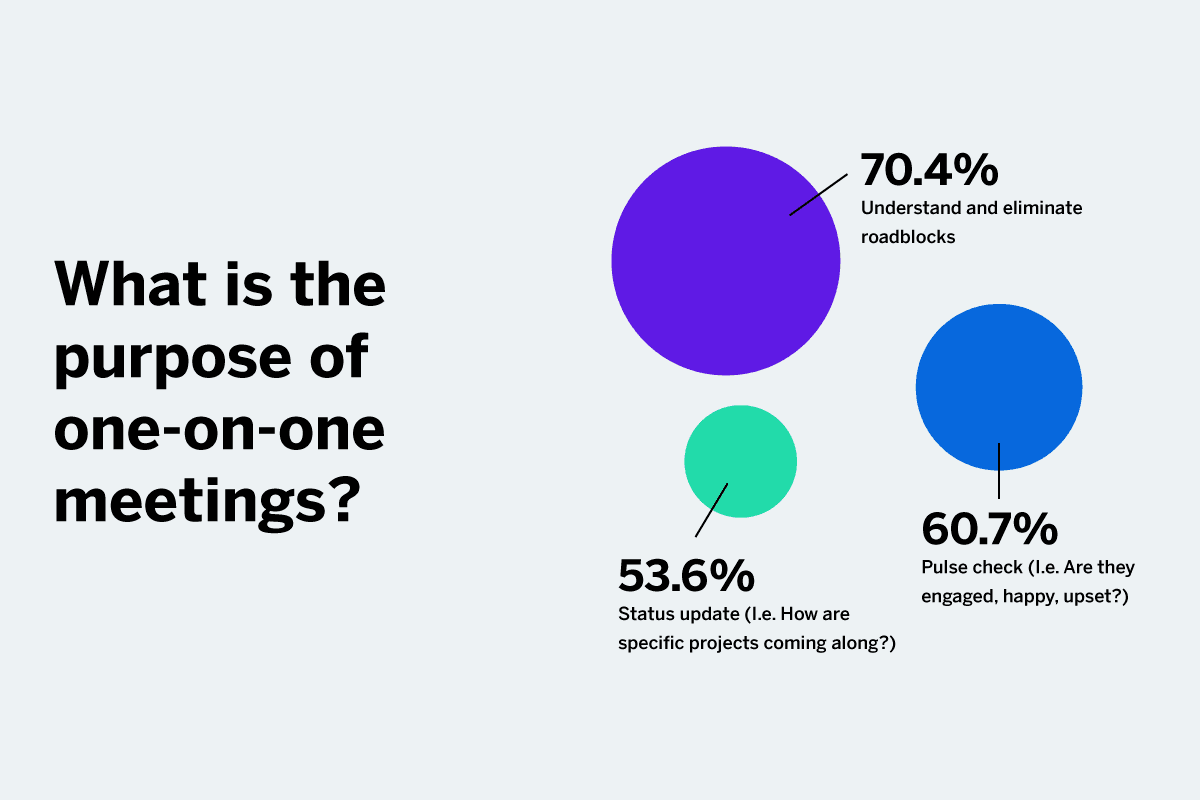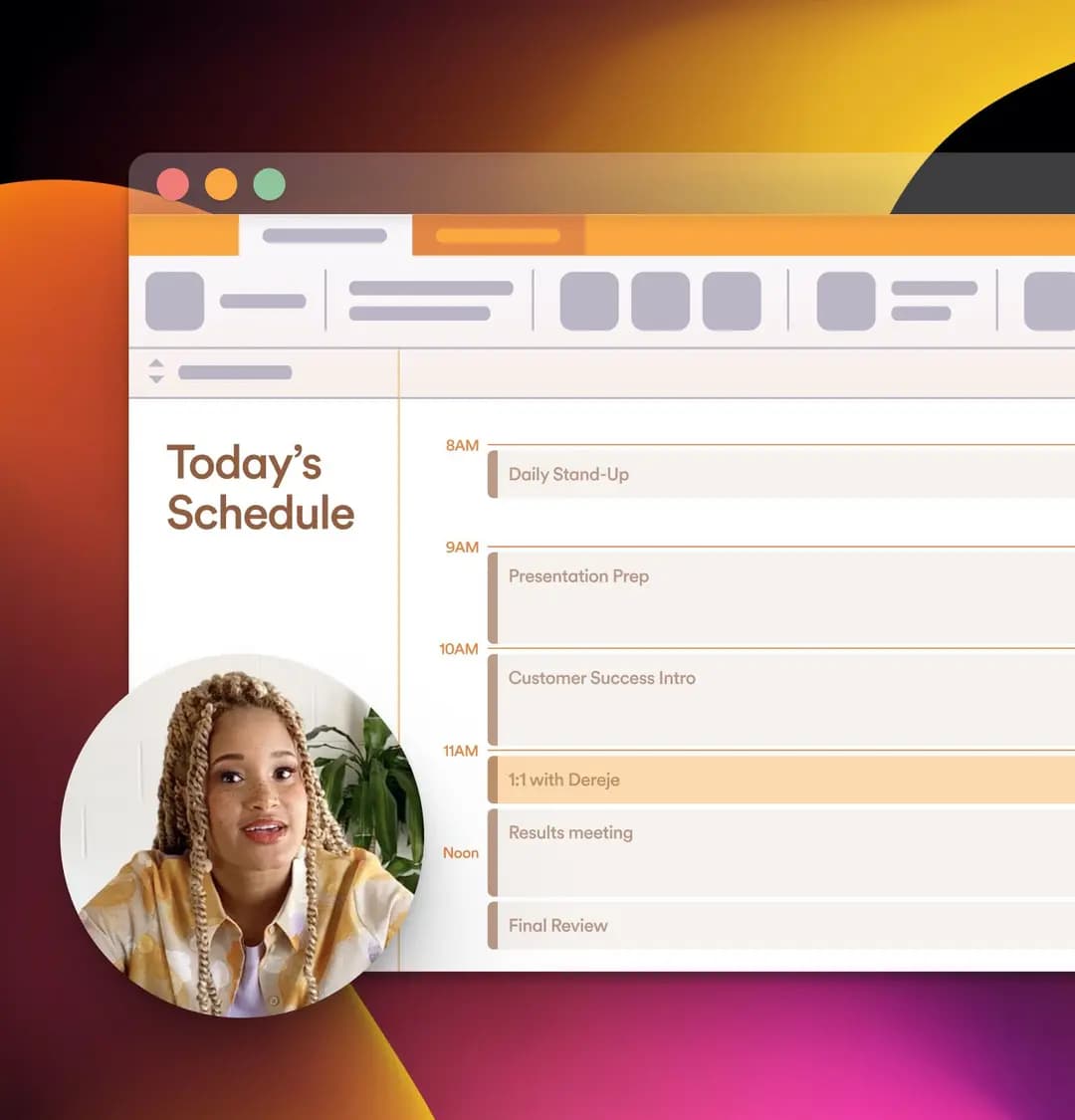Picture this: An employee sits through a weekly one-on-one meeting with their manager, feeling increasingly disconnected. The conversation is surface-level—bouncing between half-hearted inquiries like “How’s it going?” and vague updates. By the end, the employee walks away with unanswered questions, unresolved challenges, and no real sense of direction or support.
Unfortunately, scenarios like this are common. According to a 2021 Gallup poll, only 36% of employees across the U.S. feel engaged at work—meaning the majority lack a meaningful connection to their roles or workplace.
Managers have the power to flip this narrative. By prioritizing effective one-on-one meetings, they can foster connection, address pain points, and guide their teams toward shared success. Whether it’s through weekly check-ins or quarterly reviews, these meetings offer a valuable opportunity to identify and tackle disengagement as a team.
Why you need one-on-one meetings with employees
Individual meetings with employees are nearly universal across industries, yet their impact often falls short. According to Pew Research, only 49% of U.S. employees feel satisfied with the feedback they receive on their workplace performance.
Why the disconnect? While one-on-ones provide a structured opportunity for feedback, several factors may undermine their effectiveness:
Lack of actionable insights: Feedback that is overly generic or ambiguous fails to provide employees with clear steps for improvement. Saying “You’re doing fine” and not much else can leave them feeling unsupported in their professional growth.
Infrequent or inconsistent feedback: Irregular one-on-ones prioritizing immediate tasks over performance reviews can make employees feel overlooked, as they miss consistent recognition or opportunities for improvement.
Managerial discomfort or lack of training: Some managers may avoid tough conversations, opting to downplay issues or inflate praise, which can prevent employees from receiving the honest feedback they need to thrive.
Ultimately, even with one-on-ones in place, employees need tailored, constructive, and regular feedback to feel truly engaged and supported. Structuring these meetings with clear agendas and actionable takeaways is key to bridging this gap. Here are a few goals you should remember going into all of your one-on-ones.

Relationship building
The manager-employee working relationship is sometimes the most overlooked aspect of workplace satisfaction and company culture. It’s easy to let a sense of camaraderie and mentorship slip by when things get hectic, but one-on-one meetings with employees are a critical way to build trust and positive rapport with your direct reports.
Employee engagement
No one wants to feel uninspired or unhappy when reporting to work, but many do feel disengaged. According to McKinsey, employees who don’t feel engaged and do only the bare minimum, also known as quiet quitters, make up 20-40% of the workforce.
As a manager, it’s your job to foster an environment where your team members feel excited about their roles. Holding effective one-on-one meetings ensures you take time to promote individual engagement and increase workplace satisfaction.
Giving constructive feedback
Without feedback about how well they’re doing their job or how they can achieve their long-term goals, how can you expect your employees to see a clear path to career progression?
This is a good perspective to keep in mind when conducting one-to-one meetings. You can use them to provide your employees with specific Key Performance Indicators (KPIs) or metrics for success, areas in which they can improve, and how you can support them in those efforts.
If your employee’s performance isn’t meeting your expectations, a one-on-one meeting is the perfect setting to ask them about obstacles they’re facing and what you can do to help them do their job better.
Preparing for employee one-on-one meetings
Taking adequate steps to prepare for meetings with your direct reports helps you provide ample time to problem-solve, give thorough feedback on performance, and leave room for follow-up questions or feedback.
Here are some ways you can prep for your one-on-one meetings with employees:
Get to know your employees. Set aside time to familiarize yourself with each direct report's current work, areas of strength and areas for improvement, and ways you can offer support if roadblocks arise.
Share a pre-meeting Loom video. Use Loom to prepare for a meeting by recording a pre-meeting video that offers personalized information about the scope of the meeting, any KPIs you plan to address, topics you’ll discuss, and status updates or new ideas you’d like for team members to prepare ahead of time.
Establish a regular cadence. Brainstorm about tentative timelines for regular meetings with each team member to ensure that they’re getting the support and face time they need from you.
Send an agenda beforehand. Share your meeting agenda via video to organize meeting notes, provide a general idea of what the meeting will entail, and clarify goals and expectations for the conversation beforehand.
After sufficiently prepping for the meeting, you’ll feel ready to run an efficient, impactful one-on-one.
Conducting the employee one-on-one meeting

It’s one thing to plan a meeting with your team members, but actually conducting one can be intimidating, especially if you’re a new manager or new to the company.
Here are a few best practices for conducting individual meetings with your employees:
Make it personal
No matter the size of your team, it’s important to personalize your approach to each one-on-one meeting.
Every employee has different strengths, areas needing improvement, and workplace communication styles. Tailor the meeting to each individual team member to help them stay engaged—and ensure that the conversation is as productive and impactful as possible.
Balance feedback to boost morale
Formal meetings, like performance reviews, hold significant weight in shaping employee morale and engagement. These conversations can feel high-stakes, often causing stress or anxiety beforehand. To ease this tension, offer clarity about the agenda in advance, such as sharing key discussion points or encouraging employees to reflect on their accomplishments and challenges.
When delivering feedback, consider using the “sandwich” method to balance constructive criticism with encouragement:
Begin with personalized positive feedback highlighting their strengths.
Introduce areas for growth with actionable suggestions for improvement.
Conclude with affirmations of their contributions and reassurance of your support.
For ongoing feedback between formal reviews, tools like Loom can help managers stay connected with their teams. Celebrate the wins, address concerns, or clarify expectations asynchronously with personalized screen recordings. This approach fosters trust, reduces the pressure of formal meetings, and ensures employees feel valued and supported year-round.
Practice strong leadership
High-performing teams are often a direct reflection of their management's capability. When you equip your employees with clear, concrete action items, help them set measurable and attainable goals, and establish a visible path for their career development, they’re much more likely to stay efficient and productive.
These good meeting practices all start with your ability to lead. In your one-on-one meetings, you should establish a clear framework for your expectations and direct the conversation effectively. Your direct reports look to you for guidance, so this is the perfect time to step up and lead by example.
Follow up after the employee one-on-one meeting
When managing a team, the best way to ensure employee follow-through is to follow up.
This can be a personalized recap video after each meeting to remind employees what was discussed and what steps they need to take afterward. If you’re sending an asynchronous meeting recap via Loom, you can use Loom AI to identify action items you discussed and automatically generate tasks. Your direct reports can even react to your video in acknowledgment.
Following up can also mean scheduling consistent check-ins after the fact. Forbes found that 89% of HR leaders agree that continuous peer feedback and check-ins produce successful outcomes. Checking in with your employees regularly will also increase the chances of discovering potential burnout before it escalates.
You may find that your team needs a weekly stand-up meeting to keep everyone on the same page and minimize roadblocks. Alternatively, you may notice that some members benefit from more frequent status updates than others. If that’s the case, sending a Loom recording is a quick and easy way to share team updates without gathering everyone together for a meeting.
Personalizing your approach to one-on-one meeting follow-ups is a helpful way to align with good meeting practices, all while continuing to improve the dynamic between you and your employees.
How to make your employees feel comfortable during one-on-one meetings
Whether you’re conducting in-person or virtual team meetings, one-on-ones can be nerve-wracking. No matter if they are skip-level meetings or chats with a team lead, some team members may close up or shut down when they feel intimidated.

Here are some specific ways you can help your employees feel at ease during personal meetings:
Build rapport by weaving in informal conversation: Ask them about their favorite ways to unwind outside the office, connect over mutual hobbies, or discuss a recent achievement in their personal life. For instance, if an employee mentions they’ve recently started running, you might ask how their training is going. Connect on a personal level to foster trust and boost employee satisfaction.
Ask open-ended questions. Engage your team members by posing meaningful, thought-provoking questions that encourage deeper discussion. Open-ended questions allow employees to share their perspectives, helping them feel heard and providing you with valuable insights. For example:
Open-ended: "What do you think could make our team collaboration even stronger?"
Closed: "Do you like the current workflow?"
Use neutral body language. Even in difficult conversations, avoid defensive or closed-off postures. Examples of neutral body language include maintaining eye contact, keeping your arms uncrossed, and leaning slightly forward to show engagement. Nodding to acknowledge their points and mirroring their tone without exaggeration can help convey active listening and openness.
Provide time for employee feedback. Create space for direct reports to express concerns, workshop roadblock solutions, or share feedback on areas where they need more support. You can also invite them to provide constructive feedback about your management style.
Allowing your employees to feel safe sharing their opinions builds validation and appreciation, reinforcing a culture of trust.
Use Loom to build stronger teams via intentional one-on-one meetings
Regular one-on-one meetings are among the most effective ways to manage team expectations, boost employee engagement, and foster positive workplace dynamics—provided they are conducted with purpose and intention.
These meetings should include a mix of formal performance reviews and frequent informal check-ins, cultivating a comfortable and supportive environment in both settings.
You can also use Loom’s asynchronous video tools to enhance your in-person meetings in a variety of ways:
Preparing for one-on-ones: Record a quick Loom video outlining the meeting agenda, sharing relevant data, or highlighting key discussion points.
Encouraging employee preparation: Ask your employees to use Loom to share their updates, wins, or roadblocks asynchronously before the meeting.
Providing informal feedback and coaching: Use Loom to deliver personalized feedback between meetings or to coach employees on specific tasks, ensuring ongoing support without disrupting their workflow.
Following up on action items: After a meeting, summarize key takeaways and next steps in a short Loom video to maintain alignment.
Whether you’re a seasoned supervisor ready to mentor emerging talent or a new manager preparing for your first one-on-one, taking the time to plan, communicate, and follow up will pay dividends in employee satisfaction and team performance.
Combine preparation and thoughtful tools like Loom to transform your one-on-one meetings from "just another task" into an opportunity your team looks forward to.